From Yellowface to Whitewashing in Hollywood
Some progress has been made as some films have changed their views of Asian American characters over time, from the yellow face featured in “Breakfast at Tiffany’s” to the all-Asian cast of “Everything Everywhere All at Once.” However, there are things that still need to change.
Bruce Lee was as revered in my household as a kid as Tom Cruise might have been in my friends’ houses. Scrapbooks in our house feature a mini-me in a yellow tracksuit with black stripes down the side, a gift from my uncle. I started taking martial arts classes when I was in elementary school, aspiring to become the next Bruce Lee. His story was also my first introduction to racism against East Asians: In Dragon: The Bruce Lee Story, Lee’s future mother-in-law begins to warn Lee and his fiancé against having “yellow” babies. I had to ask my parents what it meant to be yellow and learned that it was a derogatory term people used to refer to East Asians.
I remember when Crazy Rich Asians came out. I was around twelve years old and sitting in the car after a school function. Another one of the few Asian families in town came over to our car to catch up with my parents. They started raving about the new movie they just watched about Asian people. I was perplexed as to why this was such a big deal, but upon their recommendation, my family sat down to watch it. It was a good movie, but I kept waiting for a White protagonist to show up. When one didn’t, I shelved it in my memory as a good story, but the confusion over where the White person was remained.
I rewatched the movie five years later, and everything suddenly began to make sense. After years of never seeing myself in the media, I realized how amazing and empowering it was to see an all-Asian cast. I finally decided to do some of my own research and find out where the Asian protagonist was. I wanted to understand why and how the film industry had such a startling lack of AAPI characters. I started out by learning about where the unfairly marginalized characters came from.
As it turns out, a strange fear of Asians emerged in the 19th century alongside a mass immigration of Chinese people to the United States. It was called the Yellow Peril and referred to the idea that Asians would take over the country and rid the world of Western values. It led to a perception of all Asians as sinister and untrustworthy. Collectively, Eastern Asians would be dehumanized, stereotyped, and oppressed for the coming centuries.
Ideas like the Yellow Peril had a widespread effect, including how the media portrayed Eastern Asians. Roles were few and far between for Asian actors, and many Asian characters were portrayed by White actors wearing yellowface.
Two iconic characters– Mr. Yunioshi, from Breakfast at Tiffany’s, portrayed by Mickey Rooney, as well as Boris Karloff’s depiction of the evil supervillain Fu Manchu- showcase extreme cases of yellowface. Yellowface is a practice in which non-Asians dress up in an attempt to look Asian, frequently for film. Mr. Yunioshi is made out to be a caricature of an East Asian. In order to achieve his look for the movie, Rooney wore a spray tan, prosthetic buck teeth, taped-back eyes, and thick glasses. He sported an exaggerated Japanese accent, greatly contrasting the soothing transatlantic accent of the White characters.
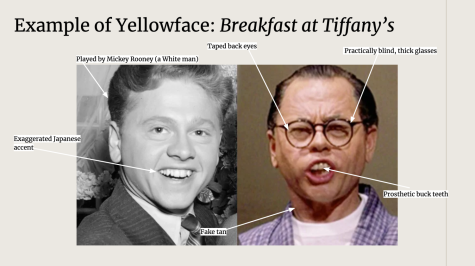
For Karloff, long nails, bony hands, squinted eyes, and upturned eyebrows were combined to create a stereotypical Chinese character. In addition, a long, thin mustache was placed on his face. This mustache was used frequently in other depictions of evil Asian characters on screen over the years.
A lack of opportunities for Asian actors to star in Hollywood has made it difficult for East Asian audiences to see themselves in the media. Though yellowface has fallen out of favor, whitewashing has taken its place. Whitewashing occurs when a canonically Asian character or character that would make more sense being Asian (such as one where every other character around them is Asia and the film is set in an Asian country) is played by a White actor. Recent movies that contain whitewashing include Doctor Strange (2016), in which the role of The Ancient One is played by Tilda Swinton (a White woman) despite canonically being a Tibetan man; Ghost in the Shell (2017) in which Scarlett Johannsen (a White woman) plays the canonically Japanese protagonist; and Aloha (2015), in which Emma Stone portrays the Chinese-Hawaiian Allison Ng. Whitewashing takes away from the already-limited opportunities for Asian actors in American media and demonstrates how racism persists in Hollywood today.
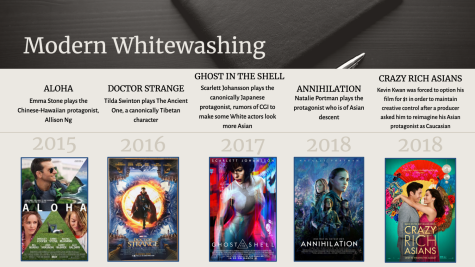
Recently, some progress has been made in terms of creating a less racist Hollywood. In 2018, Crazy Rich Asians became the first film to star an all-Asian primary cast in 25 years. The film, according to Corinne Mitsuye Sugino, “allowed for character development outside of racial tropes,” something that has rarely been seen in Hollywood for Asian characters. In addition, Everything Everywhere All At Once (2022), which featured a primarily Asian cast, received eleven Oscar nominations, showing that Asian actors may finally be getting the recognition they deserve. Some are trying to make amends for past, racist portrayals of Asians in the media. Many streaming services now air a content warning before Breakfast at Tiffany’s (1961) is shown, while one news channel edited Mr. Yunioshi out entirely– a move which led many to realize that Mr. Yunioshi was simply there as a scapegoat and comedic relief, irrelevant to the storyline.
The transition from yellowface to whitewashing is stunning, even impressive, to me. The ease with which the country accepted this still-racist alternative to yellowface is a testament to the deeply rooted racism within the film industry. One would think that after years of discrimination and invisibility in Hollywood, whitewashing would be considered more shocking than it currently is. It has become terrifyingly normalized.
The majority of the necessary change must take place inside the industry: Hollywood itself must change. By providing more opportunities for Asian actors must be created and whitewashing should be shamed and eliminated. However, there are always opportunities for improvement within the movie-watching community as a whole. The next time you visit the movies, take a look at who is on screen. How much, if any, diversity is reflected in the cast? How many Asian actors fall into stereotypical roles? Do your research about the movies you choose to watch. Was whitewashing brought up in the writer’s room? Did it actually happen? Being able to recognize racist portrayals and identify whitewashed characters are the first steps in fighting racism in Hollywood.
I am only seventeen right now, yet even I grew up with few Asian role models in the media. I want my baby cousins to grow up with more representation than I had growing up. One day, maybe, with a more progressive film industry and moviegoers who demonstrate awareness of what they are watching, this could become a reality.
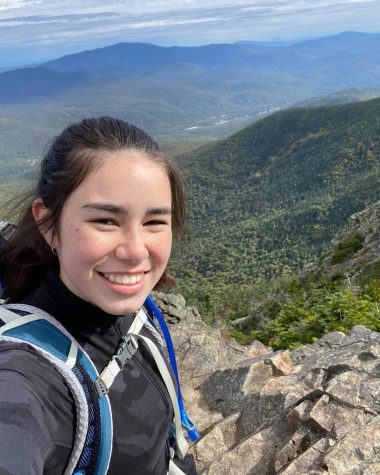
Ella Tran is a senior at Hamilton-Wenham Regional High School. She loves swimming and is captain of the HWRHS swim team, She enjoys playing the violin...

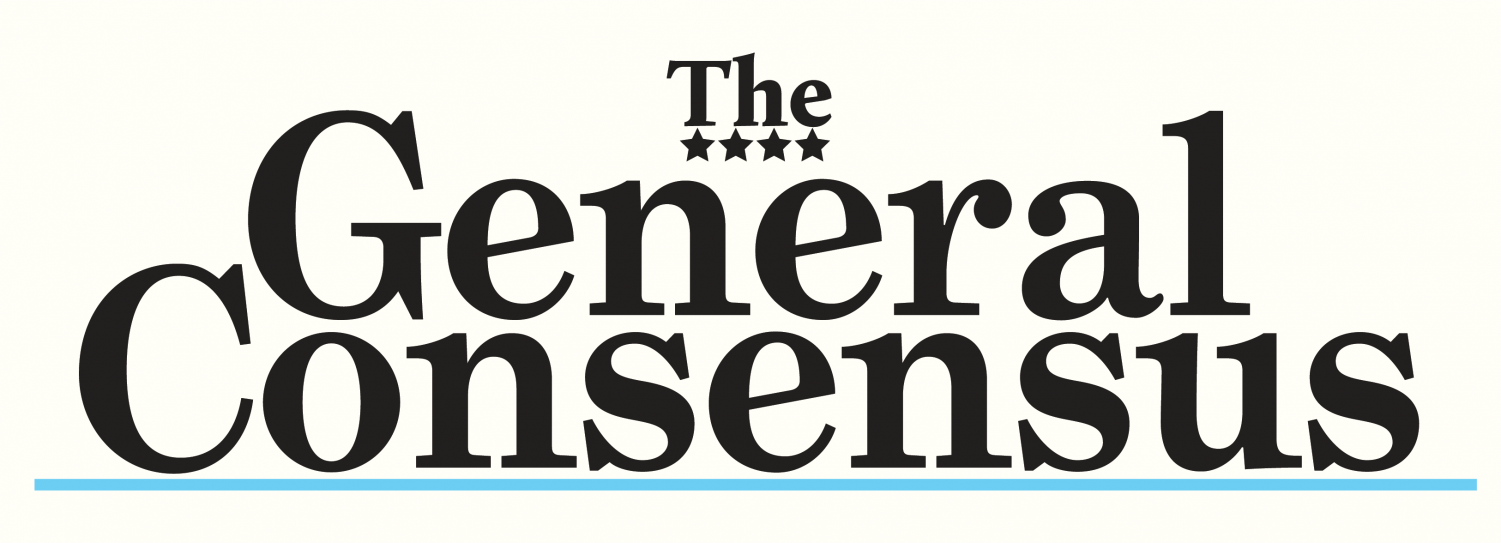
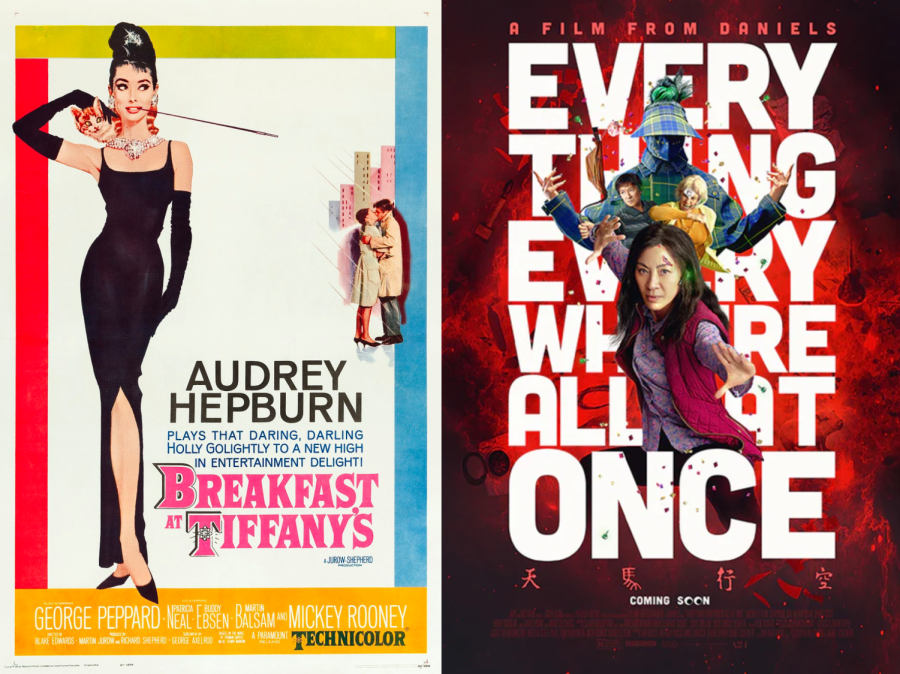








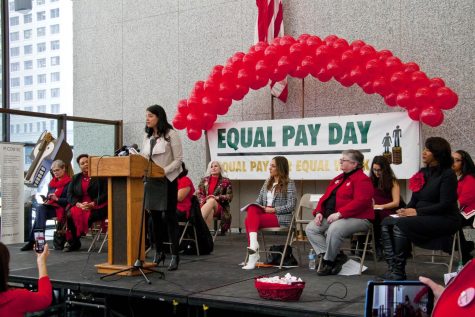
Georgia • May 28, 2023 at 10:45 am
This article is bringing up many great points that need to be talked about more such as the responsibility of the audience to not accept something just because it is normalized in media.